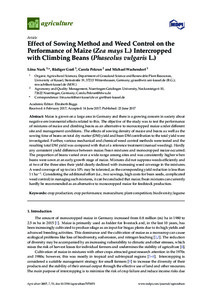Suche
Anzeige der Dokumente 1-7 von 7
Aufsatz
 Construction and Use of a Simple Index of Urbanisation in the Rural–Urban Interface of Bangalore, India
Construction and Use of a Simple Index of Urbanisation in the Rural–Urban Interface of Bangalore, India
(2017-11-21)
Urbanisation is a global trend rapidly transforming the biophysical and socioeconomic structures of metropolitan areas. To better understand (and perhaps control) these processes, more interdisciplinary research must be dedicated to the rural–urban interface. This also calls for a common reference system describing intermediate stages along a rural–urban gradient. The present paper constructs a simple index of urbanisation for villages in the Greater Bangalore Area, using GIS analysis of satellite images, and combining ...
Aufsatz
 Effect of Sowing Method and Weed Control on the Performance of Maize (Zea mays L.) Intercropped with Climbing Beans (Phaseolus vulgaris L.)
Effect of Sowing Method and Weed Control on the Performance of Maize (Zea mays L.) Intercropped with Climbing Beans (Phaseolus vulgaris L.)
(2017-06-23)
Maize is grown on a large area in Germany and there is a growing concern in society about negative environmental effects related to this. The objective of the study was to test the performance of mixtures of maize and climbing beans as an alternative to monocropped maize under different site and management conditions. The effects of sowing density of maize and beans as well as the sowing time of beans on total dry matter (DM) yield and bean DM contribution to the total yield were investigated. Further, various ...
Aufsatz
 Aqueous Leaching Prior to Dewatering Improves the Quality of Solid Fuels from Grasslands
Aqueous Leaching Prior to Dewatering Improves the Quality of Solid Fuels from Grasslands
(2018-04-04)
Renewable energies are necessary to reduce greenhouse gas emissions in energy production, and biomass plays a dominant role in the renewable energy sector. Combustion of biomass constitutes an efficient conversion technique, but is hindered by harmful elements which are frequently contained in residual grassland biomass. We investigated the effect of leaching on solid fuel quality with three independent experiments including the following treatments: (1) with or without leaching, (2) with leaching at various water ...
Aufsatz
 Heavy Metals and Polycyclic Aromatic Hydrocarbons in Urban Leaf Litter Designated for Combustion
Heavy Metals and Polycyclic Aromatic Hydrocarbons in Urban Leaf Litter Designated for Combustion
(2017-03-03)
Vast amounts of leaf litter have to be disposed of by city administrations. This biomass has the potential for energy conversion, but contamination with pollutants can adversely affect this usage. We investigated leaf litter samples from the city of Kassel by analyzing their heavy metal and polycyclic aromatic hydrocarbon (PAH) concentrations. Leaf samples were indeed contaminated with heavy metals and PAHs and contamination was influenced by provenience and collection technique. A simple cleaning system of washing ...
Aufsatz
 High-Quality Solid Fuel Production from Leaf Litter of Urban Street Trees
High-Quality Solid Fuel Production from Leaf Litter of Urban Street Trees
(2016-11-30)
Leaf litter is a growing concern for cities. Due to adherent dirt such biomass is rarely utilized nowadays but may constitute a renewable energy source for communities or private households. Leaf litter from main roads, residential areas and city centres collected by the vacuum technique or the sweeper technique was sampled and analysed for ash content and chemical composition. Ash content of leaf litter collected by the sweeping technique was higher (21.6%–40.1% dry matter, DM) than in material collected by the ...
Aufsatz
 Fusion of Ultrasonic and Spectral Sensor Data for Improving the Estimation of Biomass in Grasslands with Heterogeneous Sward Structure
Fusion of Ultrasonic and Spectral Sensor Data for Improving the Estimation of Biomass in Grasslands with Heterogeneous Sward Structure
(2017-01-21)
An accurate estimation of biomass is needed to understand the spatio-temporal changes of forage resources in pasture ecosystems and to support grazing management decisions. A timely evaluation of biomass is challenging, as it requires efficient means such as technical sensing methods to assess numerous data and create continuous maps. In order to calibrate ultrasonic and spectral sensors, a field experiment with heterogeneous pastures continuously stocked by cows at three grazing intensities was conducted. Sensor ...
Aufsatz
 Using Grass Cuttings from Sports Fields for Anaerobic Digestion and Combustion
Using Grass Cuttings from Sports Fields for Anaerobic Digestion and Combustion
(2017-03-18)
Sports fields provide a recreation space for citizens, but also generate grass biomass, which is cut weekly during the main seasons and therefore could be used in energy generation (combustion or anaerobic digestion). To evaluate the technical suitability of the grass cuttings, silage was produced from four sports fields during one vegetation period and investigated for relevant properties. Potential methane yield was determined with batch tests. Mean methane yield was 291.86 lN·kg−1 VSadded (VS, volatile solid). ...







